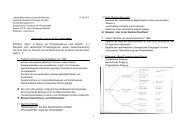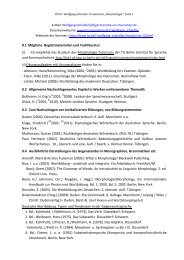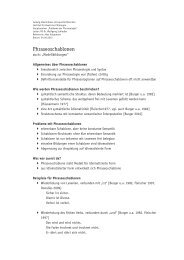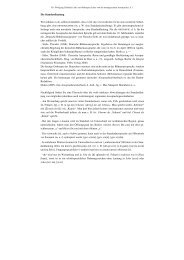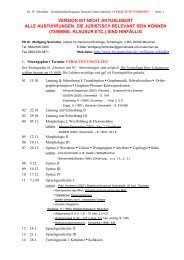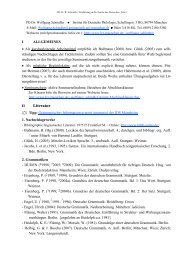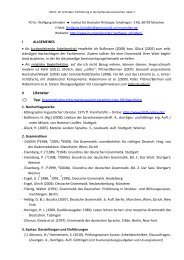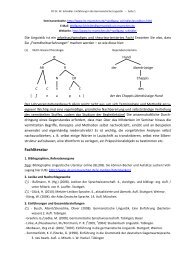Chapter 18 Lexical Functions: Description of Lexical Relations in a ...
Chapter 18 Lexical Functions: Description of Lexical Relations in a ...
Chapter 18 Lexical Functions: Description of Lexical Relations in a ...
Create successful ePaper yourself
Turn your PDF publications into a flip-book with our unique Google optimized e-Paper software.
—<strong>Chapter</strong> <strong>18</strong>. <strong>Lexical</strong> <strong>Functions</strong>— 83<br />
(red/white) blood cells; B. coagulates; hot-blooded [animal]; blood-shot [eyes]<br />
2) Bleed<strong>in</strong>g<br />
bleed; B. oozes, pours, spurts, squirts; draw, spill B.; blood-sta<strong>in</strong>ed; B. cakes;<br />
puddle <strong>of</strong> B.<br />
3) Medical Treatment<br />
blood pressure; transfusion; blood test; donate B., donor, blood-drive; blood clot;<br />
hematology<br />
4) Temperament/feel<strong>in</strong>gs<br />
cold/hot B.; B. boils/freezes; <strong>in</strong> cold B.; blood-curdl<strong>in</strong>g<br />
5) Symbol <strong>of</strong> life<br />
shed/spill B.; to the last drop <strong>of</strong> B.; crush/drown <strong>in</strong> B.; rivers/sea <strong>of</strong> B.; bloodshed,<br />
bloodbath; bloodthirsty<br />
6) Biological orig<strong>in</strong><br />
<strong>of</strong> the same B.; German and Armenian B.; blue, good, pure, royal B.; [pr<strong>in</strong>ce] <strong>of</strong> the<br />
B.; related by B.; run <strong>in</strong> the B.<br />
NB : I by no means <strong>in</strong>sist on this description. It seems preferable, as many English dictionaries do, to separate the<br />
noun BLOOD <strong>in</strong>to several LUs: BLOOD1 (body liquid), BLOOD2 (B.1 as symbol <strong>of</strong> emotions), BLOOD3 (B.1 as<br />
symbol <strong>of</strong> life), and BLOOD4 (B.1 as symbol <strong>of</strong> biological orig<strong>in</strong>). But even then BLOOD1 will have three facets. This<br />
example is purely illustrative.<br />
For the LU NOSE, at least two facets must be dist<strong>in</strong>guished: the nose as an organ and as an<br />
esthetic element.<br />
NOSE (part <strong>of</strong> the face...)<br />
1) Anatomy/physiology<br />
nostrils, nasal cavity; bridge <strong>of</strong> the N.; breathe through the N.; head cold, runn<strong>in</strong>g,<br />
stuffed N., snot; blow/wipe one’s N.; pick one’s N.; handkerchief; kleenex<br />
2) Esthetics<br />
Greek, Roman, aquil<strong>in</strong>e N.; pug, snub, bulbous, turned-up N.<br />
6.1.4 <strong>Lexical</strong> <strong>Functions</strong> and Their Relation to the Def<strong>in</strong>itions <strong>of</strong> their Keywords<br />
The whole specificity <strong>of</strong> LFs follows from their <strong>in</strong>timate semantic relatedness to their key-<br />
words. For <strong>in</strong>stance, if a lexical unit L has a Magn, its mean<strong>in</strong>g (L) tends to <strong>in</strong>clude a gradable<br />
component, which is to accept the <strong>in</strong>tensification and to which Magn actually applies (but see<br />
below, at the end <strong>of</strong> this subsection). In X’s serious INJURY, what is <strong>in</strong>tensified by SERIOUS is the<br />
component (<strong>in</strong>terference with X’s normal function<strong>in</strong>g) (<strong>in</strong> the mean<strong>in</strong>g <strong>of</strong> INJURY); <strong>in</strong> X highly<br />
RECOMMENDS Y to do Z, HIGHLY <strong>in</strong>tensifies the component (X <strong>in</strong>cites Y to do Z); etc. If for f(L)


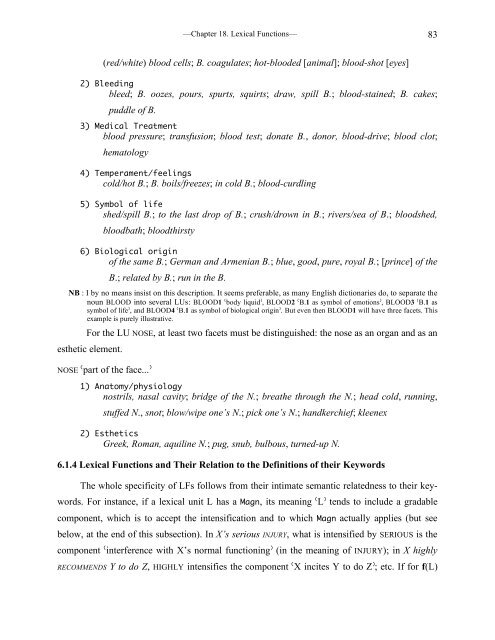
![E-Mail: Wolfgang.Schindler[ätt]germanistik.uni-muenchen.de Web ...](https://img.yumpu.com/51590147/1/184x260/e-mail-wolfgangschindlerattgermanistikuni-muenchende-web-.jpg?quality=85)
